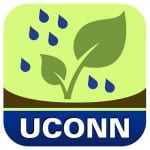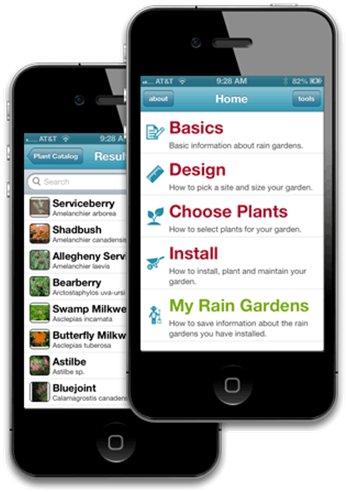By: Sheila Foran, UConn Today & David Dickson, UConn Extension
The Center for Land Use Education and Research (CLEAR), a partnership between Extension and NRE in the College of Agriculture and Natural Resources and CT Sea Grant, has developed the Rain Garden smart phone app in Apple’s iTunes store. It is the University’s first mobile app geared toward the public. Landscapers, contractors, and homeowners can use the app to design, install, and maintain rain gardens.
A rain garden is a depression (about 6 inches deep) that collects storm water runoff from a roof, driveway, or yard and allows it to infiltrate into the ground. Rain gardens are typically planted with shrubs and perennials and can add colorful, landscaped areas to yards and office or school complexes. In addition to being attractive, they benefit the environment by preventing erosion, filtering runoff pollution, removing standing water, and creating a habitat for birds and butterflies.
David Dickson, Assistant Co-op Extension Educator in Residence in the Department of Extension, says, “I started thinking that the contractors and landscapers we [CLEAR] work with probably have smart phones with them at all times … their trucks and their phones are what they use for an office … and I thought it would be great if they had a reference right there to help them with planning and laying out the gardens.”
Dickson talked it over with Mike Dietz, Assistant Co-op Extension Educator in Residence, and Chet Arnold, Cooperative Extension Educator, both in the Department of Extension, and the idea began to take shape.
While many extension programs around the country, including UConn, have focused on training landscapers and others on proper rain garden design and installation, this training often involves classroom instruction and guidebooks or printed presentation material. UConn’s utilization of a mobile app is revolutionary. Mike O’Neill, Associate Dean for Extension and Outreach in CANR says, “The folks at CLEAR are not just being innovative locally. This app has national implications. In the future, this is how knowledge will be delivered.”
While Dickson, Dietz, and Arnold knew that they wanted to include everything from basic information about rain gardens to tips on picking a site, suggestions for native plants, and soil drainage maps, they didn’t have the background to actually design the app.
That’s how Ph.D. student Alberto De La Rosa Algarin came into the picture. Algarin, who is studying information security in the Department of Computer Science and Engineering, was approached by his advisor, Professor Steve Demurjian. When asked if he’d like to collaborate with a couple of master’s level students in the design of the app, Algarin was quick to say yes. “I thought it would be a good problem-solving exercise,” he says. ”Even though it wasn’t directly tied to my research, I thought it would be a good opportunity to learn something new.”
“I didn’t know anything about rain gardens until I started working on the app with Mike and David; it’s amazing they [rain gardens] are everywhere. I had seen the garden on the roof of the classroom building [The Rowe Center for Undergraduate Education] but I hadn’t realized its importance.”
In its final phase, the app includes sections on how to actually install a garden, plant selection guidelines focusing on native plants, drainage charts, and information on how to pick a site and size of garden. This information is available right down to the location of individual addresses, making planning specific to a plot of land, not just a general area.
Landscapers will find the app particularly useful because the ‘My Rain Garden’ section actually allows users to design and organize multiple gardens. On an individual basis, homeowners can search for plants that will particularly enhance their landscapes, as well as providing individual notifications to remind them about watering and plant care.
An added benefit to CLEAR is that when users export key information about their gardens to the Department of Extension, the staff will be able to quantify storm water volume treated by the gardens in the state, as well estimate pollutant load reductions.
The app is now available through Apple’s iTunes App Store as “Rain Garden.” In its first two weeks of release it had already been downloaded 682 times. The team is now working on a version for Android devices and hopes to have it available in the next few months and hopes to release a national version of the app soon – it currently is focused primarily on Southern New England.
In the words of O’Neill, “These guys [from CLEAR] are creating a whole new path for how Cooperative Extension is going to look in the 21st century; that’s what’s so cool about this app. Everyone with an interest in rain gardens benefits and it sets the stage for the future.”

